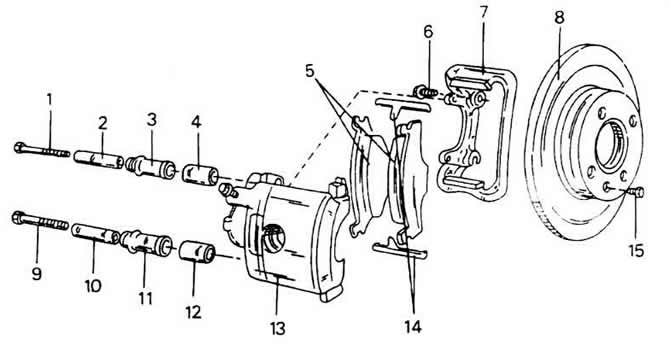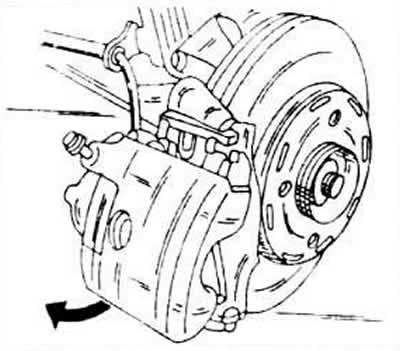
1 - top screw, 25 Nm
2 - top spacer sleeve
3 - top sleeve
4 - top guide sleeve
5 - set of brake pads
6 - brake seat screw, 125 Nm
7 - brake seat support
8 - brake disc
9 - bottom screw, 25 Nm
10 - lower spacer sleeve
11 - lower sleeve
12 - lower guide sleeve
13 - brake seat
14 - brake shoe springs
15 - countersunk screw
The brake pads must be removed as follows.
Place the front of the car on jack stands.

Disconnect both screws and remove the cylinder body.

To do this, grasp the underside of the case and pull it up in the direction (arrow).

Remove the brake pads from the guide shafts. The mounting springs will remain on the top and bottom side of the brake seat support.
Using a piece of wood, carefully push the piston back into the hole. Since brake fluid may leak out, some fluid must be sucked out of the master cylinder reservoir.
Measure the thickness of the brake pads. If they are worn out and the thickness of the pads together with the metal plate has decreased to 7 mm, they should be replaced as a set.
Clean the released brake seat support and cylinder from brake dust. At the same time check the humidity: there should be no signs of leaks in the brake cylinder. If not, repair the brake seat cylinder or install a new cylinder.
When installing the brake pads, proceed as follows.
A brake shoe with a larger working surface is placed on the outside.

Mount both fixing springs on the brake seat support. When replacing brake pads, always install new springs.

Carefully insert the brake seat cylinder so that both screws can be screwed in at once. if you move the cylinder forward, the mounting springs may be deformed.
Tighten both screws alternately to 25 Nm.
Perform all other operations in reverse order. If necessary, correct the brake fluid level in the master cylinder reservoir. Depress the brake pedal several times to bring the brake pads closer to the disc. Tighten the wheel nuts to a torque of 110 Nm.

Visitor comments